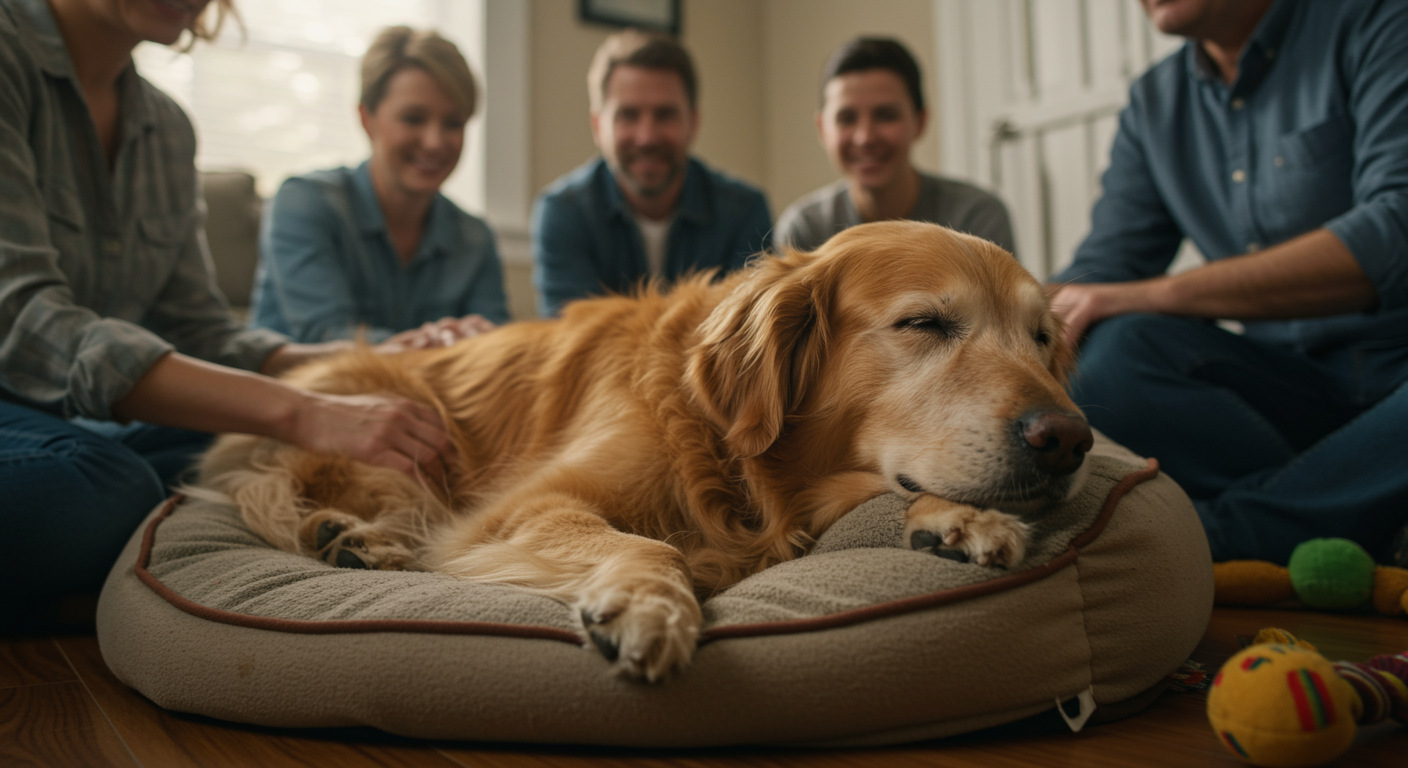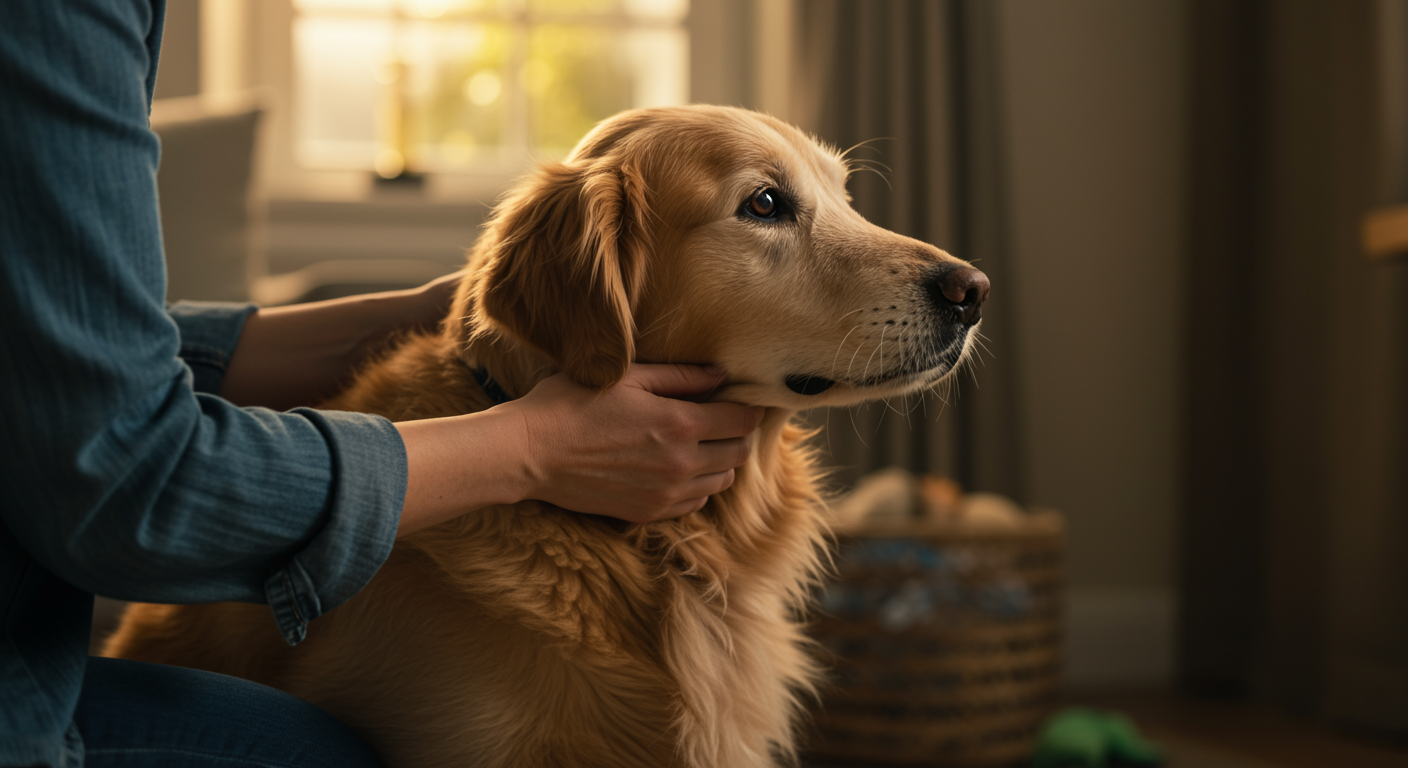Socializing senior Golden Retrievers with other pets requires patience, understanding, and careful management of interactions that respect the aging dog’s changing social needs, physical limitations, and potential behavioral adaptations that come with advanced age. Successful integration considers both the senior dog’s comfort and the dynamics of existing household pets or new additions.
Senior Golden Retrievers may experience changes in social tolerance, energy levels, and physical comfort that affect their ability to interact with other pets in the same ways they did when younger. Understanding these changes helps families create positive social experiences that enrich rather than stress their senior companions while maintaining household harmony.
Effective socialization strategies for senior dogs focus on gradual introductions, careful supervision, and environmental management that supports positive interactions while providing safe spaces for retreat when social engagement becomes overwhelming or uncomfortable.
Understanding Senior Social Needs and Changes
Age-Related Social Behavior Modifications
Decreased Social Energy and Tolerance
Senior Golden Retrievers often experience reduced interest in prolonged social interaction with other pets, preferring shorter, calmer exchanges rather than the energetic play sessions they may have enjoyed in their younger years.
Physical discomfort from arthritis or other age-related conditions can make some types of social interaction uncomfortable, requiring modifications in how other pets are allowed to approach and interact with senior dogs.
Understanding these natural changes helps families adjust expectations while creating social opportunities that remain enjoyable and comfortable for aging dogs rather than stressful or overwhelming.
Protective Behavior Changes
Some senior Golden Retrievers may become more protective of resources such as food, favorite resting spots, or human attention as they experience increased vulnerability due to physical or cognitive changes.
These protective behaviors aren’t necessarily aggression but rather adaptive responses to feeling less capable of competing or defending themselves in multi-pet household dynamics.
Understanding protective behaviors helps families manage interactions that prevent conflicts while ensuring that senior dogs feel secure and supported in their social environment.
Physical Limitations Affecting Social Interaction
Mobility and Movement Considerations
Reduced mobility may make it difficult for senior Golden Retrievers to escape from overwhelming social situations or to engage in the physical aspects of play that other pets may still enjoy.
Arthritis or joint pain can make certain types of interaction uncomfortable, requiring other pets to learn gentler approaches that don’t involve jumping, rough play, or physical contact that might cause discomfort.
Understanding physical limitations helps guide interaction management that ensures social experiences remain positive while respecting the senior dog’s comfort and safety needs.
Sensory Changes Impact
Hearing or vision changes common in senior dogs can affect their ability to read social cues from other pets, potentially leading to misunderstandings or inappropriate responses during interactions.
Reduced sensory awareness may cause senior dogs to be startled by other pets’ approaches, requiring careful management of interactions to prevent fear responses or defensive behaviors.
Understanding sensory limitations helps families create social environments that accommodate these changes while maintaining positive relationships between pets.
Introduction Strategies for New Pets
Gradual Introduction Protocols
Controlled First Meetings
Initial introductions between senior Golden Retrievers and new pets should occur in neutral territory with careful supervision and the ability to separate animals quickly if stress or conflict develops.
Understanding stress signals in senior dogs helps guide introduction pacing that prevents overwhelming experiences while building positive associations with new pet family members.
Controlled environments allow for management of interaction intensity and duration, ensuring that first impressions remain positive rather than creating negative associations that could complicate future relationships.
Scent Introduction Techniques
Allowing pets to become familiar with each other’s scents before direct interaction helps reduce anxiety and provides information that can make face-to-face meetings less stressful.
Exchanging bedding, toys, or other items between pets helps create familiarity that can ease direct introductions while allowing senior dogs to process new information at their own pace.
Understanding the importance of scent communication helps families use this natural behavior to support positive relationship development between senior dogs and new pet additions.
Environmental Management During Introductions
Safe Space Provision
Creating separate, secure areas where each pet can retreat provides essential safety valves that prevent overwhelming situations while allowing voluntary interaction choices.
Understanding the need for escape routes helps design introduction environments that support positive experiences while preventing trapped feelings that could lead to defensive behaviors.
Safe spaces should include all necessary resources including food, water, and comfortable resting areas to ensure that retreat doesn’t mean deprivation of basic needs.
Pet Socialization Management Guide
| Introduction Phase | Duration | Activities | Success Indicators | Warning Signs |
|---|---|---|---|---|
| Scent Familiarization | 3-7 days | Scent exchanges, parallel feeding | Relaxed body language, normal eating | Stress panting, avoidance, loss of appetite |
| Visual Contact | 1-2 weeks | Supervised sightings, barrier interactions | Calm acknowledgment, neutral interest | Excessive alertness, rigid posture, growling |
| Controlled Meetings | 2-4 weeks | Short supervised interactions | Peaceful coexistence, playful interest | Resource guarding, persistent tension |
| Gradual Integration | 4-8 weeks | Longer interactions, shared activities | Comfortable proximity, mutual tolerance | Ongoing conflicts, stress behaviors |
| Full Integration | Ongoing | Normal household interactions | Relaxed cohabitation, positive interactions | Regression in behavior, persistent problems |
| Maintenance | Ongoing | Monitoring, intervention as needed | Stable relationships, continued comfort | New stressors, health-related changes |
Managing Multi-Pet Household Dynamics
Resource Management Strategies
Food and Water Access
Providing separate feeding areas helps prevent competition and resource guarding while ensuring that senior Golden Retrievers can eat at their own pace without pressure from other pets.
Understanding feeding dynamics helps families create arrangements that support each pet’s needs while preventing conflicts that could create ongoing stress or anxiety.
Elevated feeding stations for senior dogs can provide easier access while creating physical separation that reduces competition pressure during meal times.
Territory and Resting Area Allocation
Ensuring that senior dogs have access to comfortable, quiet resting areas where they won’t be disturbed by other pets helps maintain their sense of security and control.
Understanding territorial needs helps families arrange living spaces that provide appropriate privacy while maintaining household harmony and positive relationships.
Multiple resting options allow senior dogs to choose locations based on comfort needs, temperature preferences, or desire for social proximity versus solitude.
Interaction Supervision and Management
Positive Interaction Encouragement
Rewarding calm, gentle interactions between pets helps reinforce appropriate social behaviors while building positive associations with multi-pet household living.
Understanding what constitutes positive interaction helps families recognize and reward behaviors that support harmonious relationships rather than accidentally reinforcing problematic dynamics.
Structured positive activities such as parallel walking or supervised play sessions can help build relationships while providing controlled opportunities for social bonding.
Conflict Prevention and Resolution
Recognizing early signs of tension or stress helps families intervene before conflicts develop, maintaining positive relationships through proactive management rather than reactive correction.
Understanding conflict triggers helps families modify environments or interactions to prevent situations that commonly lead to stress or disagreements between pets.
Quick, calm intervention during tense moments helps redirect attention while teaching appropriate boundaries without creating additional stress or anxiety.
Special Considerations for Different Pet Types
Dog-to-Dog Socialization
Size and Energy Matching
Pairing senior Golden Retrievers with appropriately sized and energy-matched dogs helps ensure that interactions remain comfortable and safe rather than overwhelming or potentially injurious.
Understanding play style compatibility helps guide supervision and intervention to ensure that interactions remain appropriate for senior dog capabilities and comfort levels.
Size considerations become particularly important when physical play occurs, ensuring that larger or more energetic dogs don’t accidentally injure or overwhelm senior companions.
Age and Maturity Factors
Senior dogs often relate better to other mature dogs who share similar energy levels and social preferences rather than young, highly energetic pets who may be overwhelming.
Understanding maturity differences helps families set appropriate expectations for relationships while providing support that helps different aged pets coexist peacefully.
Patience with relationship development allows time for pets to adjust to each other’s needs and preferences while building mutual respect and comfortable cohabitation.
Cat Integration Strategies
Predatory Response Management
Some senior Golden Retrievers may retain strong prey drives that require careful management when introducing cats, particularly if the dogs haven’t lived with cats previously.
Understanding individual dog personalities and histories helps guide introduction strategies that ensure safety while building positive relationships with feline family members.
Gradual exposure combined with positive reinforcement helps modify inappropriate responses while building associations that support peaceful coexistence rather than predatory behaviors.
Environmental Enrichment for Both Species
Creating environments that meet both dog and cat needs helps reduce competition while providing appropriate outlets for natural behaviors that support positive relationships.
Understanding species-specific needs helps families design living spaces that accommodate different preferences for privacy, territory, and social interaction.
Vertical spaces for cats and appropriate exercise areas for dogs help each species feel comfortable while reducing conflicts over shared resources or territories.
Health Considerations in Social Settings
Medical Factors Affecting Socialization
Pain Management and Social Tolerance
Adequate pain management becomes crucial for senior dogs in multi-pet households as discomfort can reduce social tolerance and increase the likelihood of defensive or aggressive responses.
Understanding the connection between physical comfort and social behavior helps families recognize when health issues may be affecting relationships with other pets.
Regular health monitoring helps identify when medical issues might be impacting social interactions, allowing for appropriate treatment that supports positive relationships.
Medication Effects on Behavior
Some medications commonly prescribed for senior dogs can affect mood, energy levels, or social responsiveness in ways that impact relationships with other household pets.
Understanding medication side effects helps families distinguish between medication-related behavioral changes and genuine social problems requiring different management approaches.
Communication with veterinary professionals about social concerns helps ensure that medical treatments support rather than complicate multi-pet household harmony.
Stress Reduction Techniques
Environmental Stress Minimization
Creating calm, predictable environments helps reduce stress that can negatively impact social relationships while supporting positive interactions between household pets.
Understanding stress factors helps families identify and modify environmental elements that may be contributing to social tension or conflicts between pets.
Consistent routines help all pets feel secure while reducing anxiety that can complicate social relationships and create ongoing household tension.
Calming Strategies Implementation
Natural calming techniques such as pheromone diffusers, calming music, or environmental modifications can help reduce stress that interferes with positive social relationships.
Understanding individual stress responses helps families select appropriate calming strategies that support their senior dog’s ability to interact positively with other pets.
Professional guidance about anxiety management helps ensure that calming interventions support social success while maintaining overall health and well-being.
Long-Term Relationship Maintenance
Ongoing Monitoring and Adjustment
Relationship Assessment
Regular observation of interactions helps identify changes in relationships that may require intervention or support to maintain positive dynamics between household pets.
Understanding normal relationship evolution helps families distinguish between temporary adjustments and concerning changes that may require professional guidance or intervention.
Documentation of interaction patterns helps track progress while identifying successful strategies and areas that may need additional attention or modification.
Adaptation to Changing Needs
As senior dogs continue to age, their social needs and capabilities may change, requiring ongoing adjustments in how other pets are managed and how interactions are supervised.
Understanding that relationships may need modification over time helps families remain flexible while maintaining positive dynamics that support all pets’ well-being.
Proactive adaptation helps prevent relationship deterioration while ensuring that senior dogs continue to benefit from positive social connections throughout their aging process.
Professional Support Resources
Behavioral Consultation
Professional animal behaviorists can provide valuable guidance for complex social situations or when conflicts persist despite family intervention efforts.
Understanding when to seek professional help helps families access appropriate resources before problems become entrenched or compromise household harmony.
Behavioral assessment helps identify underlying issues while providing targeted strategies that address specific challenges in multi-pet household dynamics.
Veterinary Behavioral Medicine
Veterinary behaviorists can address medical factors contributing to social problems while providing comprehensive approaches that integrate health care with behavioral management.
Understanding the medical aspects of behavior helps ensure that social issues receive appropriate evaluation and treatment that addresses root causes rather than just symptoms.
Integrated care approaches help ensure that both medical and behavioral needs are met while supporting positive relationships between household pets.
Quality of Life Enhancement Through Socialization
Benefits of Positive Pet Relationships
Mental Stimulation and Engagement
Appropriate social interaction with other pets provides mental stimulation that supports cognitive health while offering enrichment that enhances quality of life for senior dogs.
Understanding socialization benefits helps families appreciate the value of positive pet relationships while motivating efforts to create and maintain harmonious multi-pet households.
Social engagement can help prevent isolation and depression that might otherwise affect senior dogs, contributing to overall emotional well-being and life satisfaction.
Companionship and Emotional Support
Well-managed relationships with other pets can provide companionship that enriches senior dogs’ daily experiences while offering emotional support during challenging times.
Understanding the emotional benefits of pet relationships helps families invest in creating positive dynamics that support their senior dog’s psychological well-being.
Mutual support between pets can be particularly valuable during times when human family members are absent, providing comfort and security through companion animal relationships.
Socializing senior Golden Retrievers with other pets requires understanding, patience, and careful management that respects their changing needs while creating opportunities for positive relationships. Through gradual introductions, appropriate supervision, and ongoing adaptation to evolving needs, families can maintain harmonious multi-pet households that enrich their senior dog’s quality of life.
Success in senior dog socialization comes from recognizing individual limitations while providing supportive environments that allow for meaningful relationships with other pets. With proper attention and management, senior Golden Retrievers can continue to enjoy the companionship and stimulation that positive pet relationships provide throughout their golden years.
The investment in thoughtful socialization demonstrates commitment to comprehensive senior dog care while ensuring that social needs are met in ways that support rather than stress aging companions during this important life phase.

Rafael Souza is a digital marketing strategist and lifelong dog enthusiast. Passionate about Golden Retrievers, he shares practical, research-based tips to help owners provide healthier and happier lives for their furry companions.





